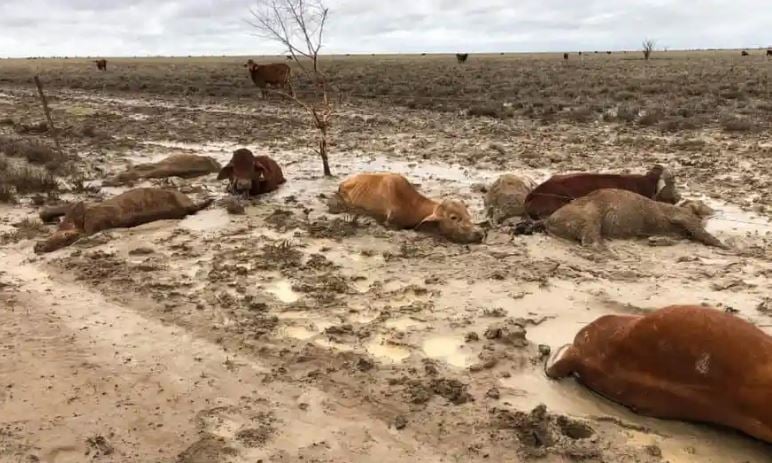After thousands of cows and chickens died in Uruguay and Argentina due to extreme heat, up to 300,000 cattle have died during the unprecedented floods that engulfed Townsville and the western region of Queensland, Australia in the last few days. Graziers have been confronted with scenes described by one mayor as “hell”, as it became clear up to 300,000 cattle had died in the floods.

Premier distanced herself from decision to open Ross River dam floodgates, which sent water into Townsville suburbs.
Well now look at that! It’s dramatic:
But on Friday, the mayor of Townsville, Jenny Hill, told that some rainfall readings were at levels probably recorded once every 2,000 years.
“A team of experts is analysing the data, but it is clear the flood levels in the Ross River were greater than a one in 500 years event,” Hill said. “There were rainfall totals over the Ross River dam catchment that were in excess of one in 2,000 years rainfall event.”
Now from Youtube:
The decision to open the floodgates on Sunday night, when the dam water level reached 43 metres, was in line with the dam’s management plan, and based on a 2012 study that also assessed the impact of opening the spillway earlier.
It said waiting until 43 metres would save about 960 homes in a one in 100-year flood. But doing so would cause greater property damage – affecting about 600 more properties – in the sort of situation that faced Townsville this week.
When the gates were opened fully on Sunday night, so much water had built up that 1,900 cubic metres of water per second spilled into the Ross River. The release was the direct cause of much of the flooding experienced in low-lying Townsville suburbs.
The impact was felt most severely at Idalia, where properties had been built mostly during the past two decades, and which were considered to be effectively free of the risk of flooding. Planning decisions are based on whether properties would be inundated during a one in 100-year flood. Many residents in that area told Guardian Australia they believed their properties, mostly built on concrete slabs without flood mitigation measures, were not at risk.
Professor Jamie Pittock of the Australian National University said authorities in Australia typically made planning and flood management decisions based on the “one in 100” year designation. In Europe and the United States, contingencies are made for more extreme natural disasters.
“We’re creating trouble by not planning for those [extremes],” Pittock said. “What today is the one in 100-year flood, in five years’ time it could well be the one in 50-year flood.”
And the cattle
Meanwhile in western Queensland, the floodwaters have killed up to 300,000 head of cattle, and the losses have been put at a staggering $300m.
Here some terrifying pictures of the aftermath of the floods by Jacqueline Curley from JCurley Photos and found on VK:
The mayor of Richmond, John Wharton, said there had been huge stock losses in his area, as well as McKinlay shire, and parts of Flinders and Cloncurry shires.
The rural lobby group AgForce warned that thousands more cattle could be dead by the weekend unless emergency fodder shipments reached them immediately.
“This is a disaster,” Wharton said. “Cattle just couldn’t move, the water just kept rising and rising and the water broke its banks.
“There are railway lines washed away, the roads are buggered and there is a lot of cattle gone. They could not survive. It was just hell.”
Palaszczuk has toured the flood-hit Cloncurry area, and at times stumbled over her words as she struggled to describe what she had witnessed.
“We went along a road with the mayor for about 20 minutes and to the right of me was a sea of dead cattle,” she said on ABC radio.
“To see the cattle spread across these yards, not moving … it made you feel sick in the stomach. It’s really hard for words to describe it.”
She said it was clear many animals had endured agonising deaths and the confronting scenes demonstrated the level of help graziers would need to recover.
“These cattle producers have gone through an extended period of drought and they’ve come smack bang into a natural disaster.”
Wharton said many farmers had run down their herds to survive years of crippling drought and now faced devastation.
“There are a lot of broken-hearted people,” he said. “Emotionally, they are not doing real well.”
The prime minister on Friday afternoon announced the grants to flood affected areas that were set at $25,000 on Thursday, had been raised to $75,000. Scott Morrison also said the commonwealth would provide an additional $3m to support mental health services in flood affected areas.













Reptilian shape-shifter in Australia’s Weather Bureau
https://spacetravelinalabama.com/2019/02/08/reptilian-shape-shifter-in-australias-weather-bureau/